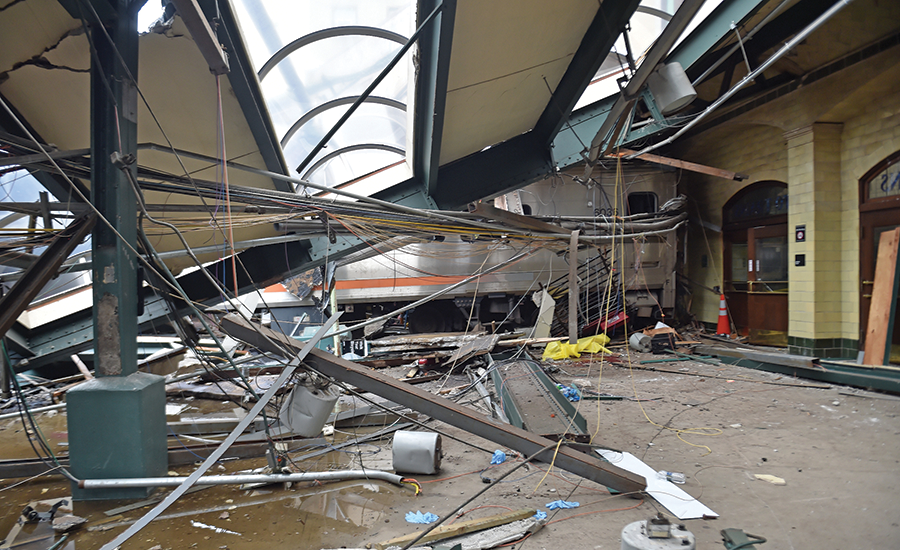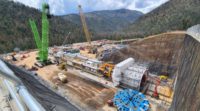After a three-month political standoff over funding that halted thousands of state-funded road and rail upgrades in peak construction season, New Jersey politicians reached agreement on controversial tax hikes—including a new 23¢-per-gallon levy on fuel—to restart work. The Sept. 30 deal in Trenton came the day after a New Jersey Transit (NJT) commuter train slammed into the Hoboken terminal. The crash killed a woman standing on the platform, injured more than 100 passengers and caused major damage to the station. The timing fueled media and industry speculation that the deal accelerated as concern rose over inadequate state infrastructure funding.
A federal probe led by the National Transportation Safety Board continues into the Sept. 29 crash that killed Fabiola Bittar de Kroon, 34, when she was hit by overhead debris. The train came to rest at the joining of a rail shed, canopy and the terminal building, which was built in 1907 and recently renovated. NTSB said in briefings that one recovered data recorder from the rear locomotive dates from 1995 “and was found to be not functioning during the trip.” Recovered on Oct. 4 in in the debris-damaged first car, event and video recorders are being analyzed, said a spokesman, who did not know if they are operational. But NTSB said track inspections found “nothing that would have affected the performance of the train.”
Agency Vice Chair Bella Dinh-Zarr described the canopy as being supported by “enormous steel I-beams and composed of concrete slabs and glass.” She said, “The south side of the superstructure is intact but severely sloped, and pieces of the canopy have pierced the rail car.” Dinh-Zarr compared cleanup to “a dangerous game of pick-up sticks.” NTSB used a drone to collect 109 images of the crash area, especially the collapsed roof, in its first use of the technology to document a rail incident. While the yard speed limit is 30 mph, probers have not released data on the train’s speed. One industry executive familiar with operations there believes it was going 20 mph when it crashed.
While neither NTSB nor NJT provided details on impacts to the terminal—restored in 2005 and in 2012, after Superstorm Sandy—media reports say impacts included major damage to the interior and a partial roof collapse. So far, officials have provided no detail on repairs, a reopening date or the names of the industry firms doing cleanup and damage assessment.
Speculation tying the crash to the state Transportation Trust Fund crunch and prior squeezed infrastructure spending began immediately. “It’s hard to say whether [Republican Gov. Chris] Christie cut this deal in response to the Hoboken tragedy that occurred 32 hours earlier—perhaps just to get it off the news … or in abject fear of what could happen next,” said an Oct. 2 Newark, N.J., Star-Ledger newspaper editorial. More than 200 NJT projects were halted by the state shutdown, and media speculated about a recent spate of accidents and $500,000 in federal safety fines against the agency since 2011. Adds a transit design firm executive who works in the state but declined to be identified, the latest accident “pushed the administration over the edge.”
Project restarts still must await full legislative adoption of the deal, which includes tax cuts to offset the fuel levy.
Action was set to come by Oct. 6 or 7, say industry observers. Greg Lalevee, business manager of the 6,800-member operating engineers’ Local 825, was pleased by the deal but said he expected contractor claims against municipal owners or the state for shutdown and restart costs. One union member was laid off this month by a state paving contractor, the earliest seasonal cut in 30 years of work, he noted.
But state transportation chief Richard Hammer rejected as “irresponsible” claims that the shutdown cut NJT safety or maintenance at Hoboken or work to implement positive train control (PTC) in its 1,002-mile network. But PTC “is well behind schedule” at NJT, says one industry firm executive close to the program who cites radio-frequency allocation and fiber-optic installation issues, as well as low morale in an agency without a permanent leader since early 2016.







Post a comment to this article
Report Abusive Comment